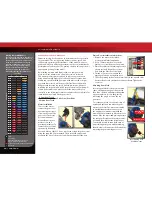
TRAXXAS • 21
TUNING ADJUSTMENTS
TRANSMISSION TUNING
Adjusting the Slipper Clutch
Your model is equipped with an adjustable Torque Control slipper
clutch which is built into the large spur gear. The purpose of the
slipper clutch is to prevent over-stressing of the drivetrain and
transmission gears. It may also be used to regulate the amount of
power sent to the rear wheels to prevent tire spin. When it slips, the
slipper clutch makes a high-pitch, whining noise.
To adjust the slipper clutch, first
remove the receiver box cover.
Next, remove the single large hex
screw from the motor plate using
the supplied 2.5mm wrench. Then
rotate the motor and mount to the
side of the model. The slipper clutch
is integrated into the main spur gear
on the transmission.
The slipper clutch is adjusted using
the spring-loaded locknut on the
slipper shaft. Use the supplied
universal wrench. To tighten or
loosen the slipper nut, insert the
1.5mm hex wrench into the hole in
the end of the slipper shaft. This locks the shaft for adjustments. Turn
the adjustment nut clockwise to tighten (less slippage) and counter-
clockwise to loosen (more slippage).
Tuning the Sealed Gear Differentials
You model is equipped with sealed, bevel gear differentials. The
differentials allow the left and right wheels to spin at different speeds
while turning. You can increase or decrease the torque transmitted
between the left and right wheels by changing the viscosity of the
silicone oil inside the differentials. The viscocity of the oil is indicated
as a weight (W). Higher weights are more viscous, meaning the oil
is “thicker.” Lower weight numbers are less viscous, meaning the
oil is “thinner.” Filling the differential with higher viscosity (thicker)
oil “tightens” the differential, transferring more power to the wheel
with the most traction. Filling the differentials with lower viscosity
(thinner) oil “loosens” the differential, transferring less power to the
wheel with the most traction. Traxxas sells a variety of differential
tuning oils specifically designed for use in your model.
Your model’s gear differentials have been tuned specifically to
provide balanced handling and authentic gymkhana-style drift-
cornering. The front differential has been filled from the factory with
high-viscosity 50,000W silicone oil. The 50,000W oil allows the front
wheels to pull the model through the turn when counter steering
through a drift. Increasing the fluid viscosity increases the authority
of the steering while drifting, but decreases the steering when not
drifting (“grip driving”). Increasing the front differential viscosity too
much will make the model difficult to drive (“twitchy”). Decreasing
the front differential viscosity will decrease the ability of the model to
drift, but will increase steering response when grip driving.
Front Differential oil viscosity tuning suggestions
• For drift cornering with a single Series 1 battery (6-cell
NiMH), use the stock differential oil.
• For drift cornering with dual Series 1 batteries (12-cell
NiMH in parallel, see page 11), use thicker/higher viscosity
differential oil (higher weight number).
• For grip driving with single or dual batteries, use thinner/
lower viscosity differential oil (lower weight number).
Tuning the rear differential fluid will allow you to fine tune the amount
of angle the model will exhibit during a drift. The rear differential is
filled with 30,000W oil to keep the rear of the model from sliding out
completely when drifting around a turn. Increasing the viscosity of the
fluid will cause the model to over-rotate resulting in a spin. Decreasing
the viscosity of the fluid will reduce the model’s drift angle. For grip
driving, lowering the viscosity will allow the model to turn more easily.
Rear Differential oil viscosity tuning suggestions
• For drift cornering with a single Series 1 battery (6-cell
NiMH), use the stock differential oil.
• For drift cornering with dual Series 1 batteries (12-cell
NiMH in parallel, see page 11), use thicker/higher viscosity
differential oil (higher weight number).
• For grip driving with single or dual batteries, use thinner/
lower viscosity differential oil (lower weight number).
WHEELS AND TIRES
You model is equipped with standard-size touring car wheels and
tires that fit 12mm axle hexes. The wheels are 26mm wide and have a
+4mm offset. The wheels are engineered specifically for your model,
but many aftermarket touring car wheels and tires can also be fitted to
alter the styling and handling characteristics of your model.




































